What are the must have teaching tools for an English kids teacher?
Teaching kids necessitates having loads of supplies at hand – some will be lesson specific and are only used for certain lesson themes, however, some classroom tools can be used over and over for many different activities.
I have a big sports bag that I take to all my kid’s classes, and along with the essentials (pens, pencils, crayons, marker pens, scissors, etc.) the following items are always given a space.
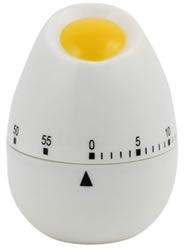 1. Egg timer and stopwatch
1. Egg timer and stopwatch
Egg timers are great for timed games, throwing around the classroom (such as for the time bomb game below) and setting time limits for tests, etc. I use mine all the time.
Time bomb: You need a timer that counts down (such as an egg timer) for this exciting game. If you can, get one that audibly ticks. Choose a category (e.g. animals, food, words beginning with ‘S’, etc.), set the timer to 1 minute. Start by saying a word in that category (e.g. for animals – elephant) and then throw the timer to a student. S/he must catch the timer and say another word from the category before being allowed to throw to another student. The student holding the timer when it goes off is out of the round. The game continues until there is one student left.
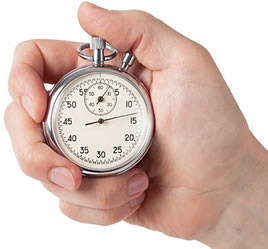 A stopwatch is a brilliant classroom supply. It can be used to add an element of competition to activities (e.g. put the alphabet in order in less than 1 minute) and students can try and beat their previous best times. It is also a good tool for the “How long does it take?” game.
A stopwatch is a brilliant classroom supply. It can be used to add an element of competition to activities (e.g. put the alphabet in order in less than 1 minute) and students can try and beat their previous best times. It is also a good tool for the “How long does it take?” game.
How long does it take?: You’ll need to set up various simple activities for students to complete and be timed. These can be written on a worksheet or on the board for students to copy into their workbooks. Some examples are:
- How long does it take you to count to 100?
- How long does it take you to say the alphabet? (forwards or backwards)
- How long does it take you to run around the classroom 10 times?
- How long does it take you to write your address?
- How long does it take you to shake hands with everyone in the class?
Students work in pairs or small groups and time each other as they do the activities. At the end you can round up all the times to find out who is the fastest in the class for each activity.
Note: you can also play the similar “How long can you?” game (e.g. How long can you hold your breath?, stand on one leg?, balance a balloon on your head, etc.).
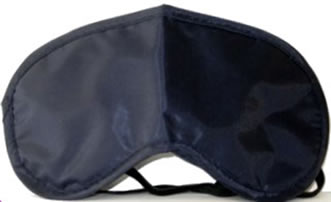 2. Blindfold
2. Blindfold
A blindfold is a great teaching supply to have (a cotton scarf is fine) as kids love to be blindfolded. I use ones that airlines give out for sleeping. There are lots of activities you can do with a blindfold:
- for question practice, have students stand in a circle with one student in the center wearing the blindfold. Spin him/her around a few times and have him ask the nearest student a question. When the student answers the blindfolded student must guess who it is.
- for fun “Where are you?”, “I’m here” games.
- for giving directions: to find a hidden object give directions to the blindfolded student, such as “Go forward (3 steps), go back, turn left, turn right”.
- have blindfold students guess objects by feeling or even food by tasting.
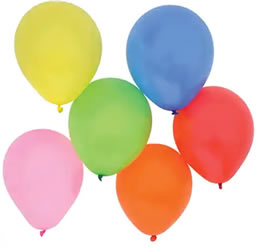 3. Balloons
3. Balloons
Kids love balloons and they make a nice souvenir at the end of the lesson. They can be used in lots of games:
- pat the balloon to each other in a circle as you say vocab, ask and answer questions, and so on.
- play No hands – teams stand in a line with one balloon per team. The balloon needs to be passed to the back of the line without using hands.
- color games for learning the colors (kick the blue balloon, touch the green balloon with your nose, etc.)
- reading & writing games – have all of your vocabulary written on different balloons (the students can do the writing). Then say a word and a student must kick the right balloon.
- racing games with a strew – students race to blow the balloon to a finish line.
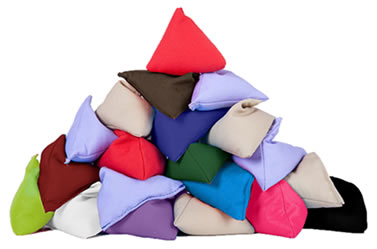 4. Beanbags
4. Beanbags
Hand-sized bean bags are a really useful classroom supply, especially for teaching actions, body parts and colors. Instructions such as the following can be used:
- Put a (green) beanbag on your head
- Put a (yellow) beanbag between your knees
- Jump over the (red) beanbag
- Pick up the (blue) beanbag
- Throw the (purple) beanbag to a friend
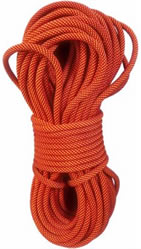 5. A length of rope
5. A length of rope
A cheap length of rope can be used in many fun ways.
- Held at a height kids can jump over or limbo under it to collect the correct flashcard or object (for little ones just lie the rope on the floor for them to jump over).
- To teach left/right, lie the rope down the center of the room, have students stand over it legs either side. Teacher shouts left and the students jump to the left, etc.
- It can be used a rope train – everyone holds the rope and follows the teacher around the classroom making train noises.
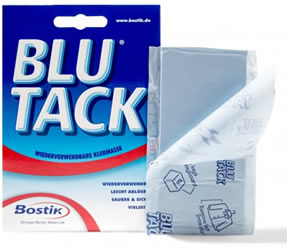 6. Blu Tack
6. Blu Tack
This is extremely useful. You can use it to stick posters, pictures, colored paper, students’ work – virtually anything on the walls of your classroom. It can also be used to stick pictures on your board (e.g. of two characters to create a dialog). It’s also good for the treasure hunt prepositions game.
Preposition Treasure Hunt: In this game students practice saying prepositions of location and yes/no questions. You need something sticky, like ‘Blu Tack’ that you can roll into a ball and stick on anything.
Model the game first: give the Blu Tack to a student and indicate that they should put it in a difficult-to-find place. Leave the room and give them a few moments to hide the Blu Tack (e.g. on the underside of a desk, on the wall behind a curtain, etc.). Then come back in and ask yes/no questions to locate it (Is it on the desk?, Is it near the desk? Is it in the front half of the classroom? Is it under the chair? etc.). When you finally find it have a student take the questioner’s role. In a large class try having students play in pairs.
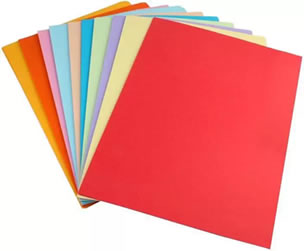 7. Origami paper
7. Origami paper
Great for teaching colors and just for doing fun paper folding. You can get it quite easily in arts and crafts stores and stationery stores. There are lots of simple activities you can do:
- Give each student two pieces of different colored paper. Teacher calls a color (e.g. “Blue”) and the students with that color hold it up.
- Give each student a different colored paper (or even 2 colors). Teacher calls a color and an action (e.g. “Blue – Jump!”). Other actions can be stand up, spin around, run on the spot, sit down, hop, wiggle, star jump, etc.
- Place different colors around the room. Teacher calls out colors and students go and touch or retrieve the origami papers.
- Give each student a color and make sure at least 2 students have the same color. Teacher says “Blues, high 5!” and the kids with blue paper need to find each other and High 5 each other.
- Make a line of papers with the Rainbow Song – as the song is played students put the papers in the same order as the song. Alternatively, the teacher puts the papers in the correct order and the students touch each paper as the song is sung.
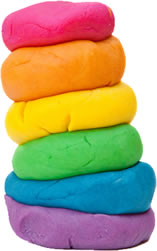 8. Play doh
8. Play doh
Play doh is such a useful supply, especially for younger students. It can be used for making food and animals, teaching colors and even used to make alphabet shapes.
You can buy it at most toy stores but it can be easily made – either before class or during class as an activity.
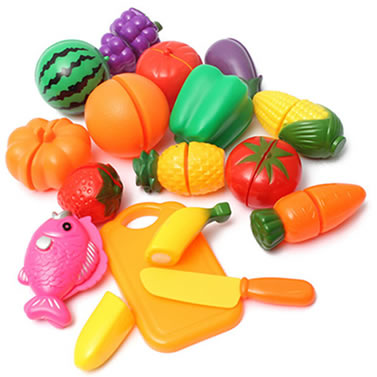 9. Bag of plastic food
9. Bag of plastic food
Food objects often come in handy. Just having these objects allows you to practice different
- food vocabulary
- colors
- likes / dislikes / favorites (e.g. Do you like apples?)
- hot / cold (e.g. Touch the food that you eat cold / hot)
- big/small (if you have different sized food objects)
- and so on
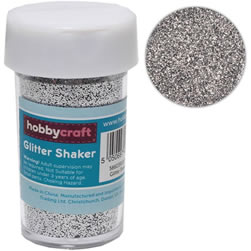 10. Glitter
10. Glitter
Kids just love using glitter with their drawings and crafts – it can really liven them up. By using a glue stick, students can draw shapes and objects, sprinkle glitter over the glue and then lift up the picture so the unwanted glitter falls off.
Some other glitter usage examples:
- weather pictures (yellow glitter sun, blue glitter rain, rainbow glitter!)
- stars and moon
- Christmas pictures
- glitter face pictures
- glittery Easter eggs
- glitter snow globes (glue figures to the inside of a jar lid, put water and glitter into a jar, close the lid and shake)
Do you have any “must have” classroom supplies not mentioned in our list above? If so, please let us know in the comments below!


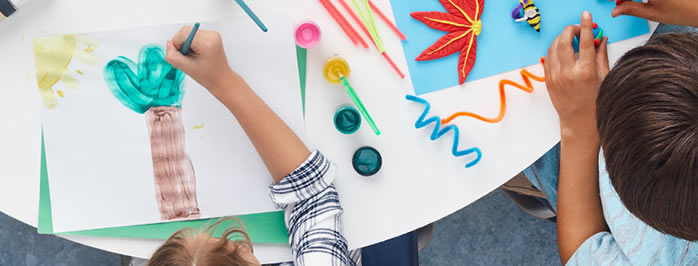

Thank you for such a wonderful website and blog. As a father and teacher, I learned a lot of useful information. The articles are very informative and interesting to read. Some things will definitely come in handy.
As an esl teacher, I profess that all these resources are so useful and helpful. Thank you for sharing.